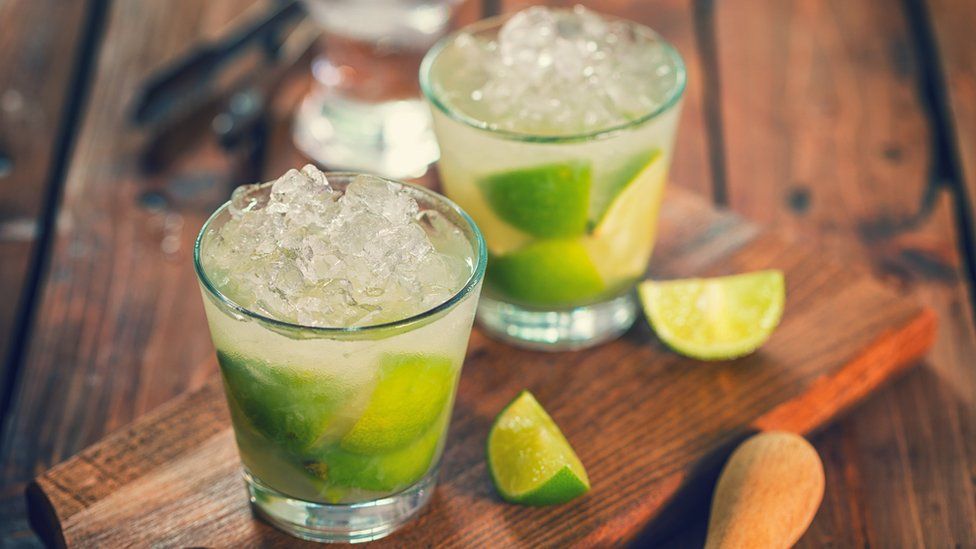Brazil hopes the world will get a taste for its favourite spirit
- Published

There is no other drink that represents Brazil more than the sugar cane spirit cachaça.
You visit a bustling bar with friends on a hot evening, and enjoy cold glasses of the country's national cocktail - caipirinha, a mixture of cachaça, sugar, and lime, with lots and lots of ice.
Or just as popular - you drink cachaça neat, downing shots to toast your companions.
Yet like the nation as a whole, the spirit has had a difficult pandemic.
With bars and restaurants across Brazil closed for long periods since last spring and households not allowed to mix, sales slumped by almost a quarter in 2020.
Producers and industry leaders now hope to boost overseas orders of cachaça, in order to compensate. But as Luciano Sadi Andrade, marketing manager at distillers Companhia Müller de Bebidas, admits: "It has always been a challenge... to explain the concept of cachaça for the foreign market."
So what exactly is cachaça? Pronounced "ka-SHAS-sa", it is distilled from sugar cane juice. This, Brazil says, makes it different to rum, which is typically made from the molasses, or thick treacle, left over after sugar cane has been processed into sugar.
Fans of cachaça say this makes it taste fresher and fruitier than rum.
Cachaça, which can only be made in Brazil, is believed to have been first distilled in the country in 1516. This means that it predates the production of both rum and tequila.
It is also regarded to be the world's third most-produced spirit, after vodka and China's baijiu.
The country makes some 800 million litres of cachaça a year, according to trade body Brazilian Institute of Cachaca (Ibrac) Yet such is the thirst for the spirit in its vast home country - less than 1% is exported.
To boost overseas awareness, earlier this year Ibrac joined forces with the Brazilian Trade and Investment Promotion Agency (Apex-Brasil) to launch a 24-month promotional drive.
Their work so far includes a website - Taste Brasil - which gives information on cachaça, how to make a good caipirinha, and details of other cocktails that can be made with the spirit. Producers are being given financial help to attend international drinks fairs and to find overseas partners.
Much work needs to be done as export sales of cachaça actually fell last year, down 24% to 5.75 million litres, from 7.3 million litres in 2019.
Ibrac director Carlos Lima says the problem was a simple one - the pandemic closed bars and restaurants around the world. "Nearly 70% of the cachaça sold abroad is used as an ingredient for cocktails, and consumed in bars."
The hope is that with greater awareness of the spirit more people around the world will be tempted to drink it at home. Mr Lima stresses its "versatility" as a mixer.
The family-owned Weber Haus is a cachaça producer that is already exporting - it's been doing so since 2004 and its bottles are now found in 25 countries, with the US being the biggest overseas consumer.
Boss Evandro Weber says overseas sales fell by 10% in 2020, but that they have since improved. "It was a difficult year but things are going in the right direction now. We have had orders from China, France, Italy and Luxemburg, for example."
To help boost overseas sales, he adds that Weber Haus has "redesigned our products, with a new layout and presentation".
Another producer that is already exporting is Cachaça da Quinta. Katia Alves Espirito Santo has been in charge since 2007. She had previously been working for the United Nations but her father persuaded her to come home and run the family firm.
The brand won an international spirits award in 2013, and from there started to sell in Taiwan, Japan, the US and France.
It now exports half its bottles but is also intent on expanding its domestic sales. When the pandemic hit and shut bars, Mrs Espirito Santo says the firm switched to focusing on supermarket and online sales.
Mr Lima says the global push will encourage drinkers to use cachaça in any number of cocktails, and not just caipirinha. The hope is that people will increasingly drink the spirit year round. "In other countries, people are (currently) still seeing cachaça as a summer drink used to prepare caipirinha."
But while cachaça producers and promoters obviously sing the drink's praises, what do overseas spirits experts think about its chances of being an international best-seller?
New Economy is a new series exploring how businesses, trade, economies and working life are changing fast.
"The availability of cachaça in Europe and the US has increased over the past few years," says Wes Burgin, the man behind the website The Fat Rum Pirate. "However, such is the size of the domestic market that a lot of the premium, small-batch, aged cachaça rarely leaves Brazil.
"It always works well in classic cocktails such as mojitos and daiquiris. However, cachaça [has] grassy, herbal and funky flavours, especially in un-aged or young cachaça, [and this] can still be a little too much for audiences in the US and Europe."
Mrs Espirito Santo adds that Brazil's more than 1,000 producers have to work together to raise global awareness. "Cachaça is a high-level distilled drink. It is tradition, art, knowledge and technology," she says.